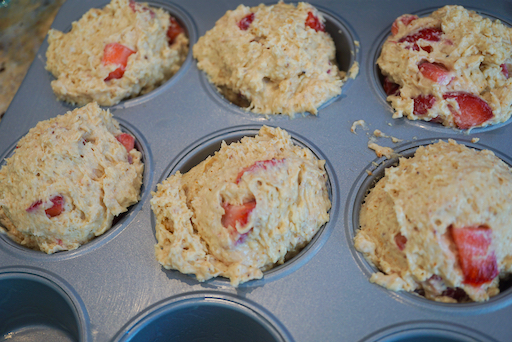This another one of my wife's muffin projects. The original recipe came from King Arthur Flour website but she replaced some of the wheat flour with almond flour. I am not sure whether she just wanted to use the almond flour before it gets stale or to reduce the carb in this muffin or make it more gluten free. I am not sure why it is called "doughnut" muffin.
Wifey's response: The blueberry and strawberry muffins I made used pulverized almonds mixed with flour as their base. I have some almond flour which is past its "best by" date but it was still ok because we were freezing it. But when the available freezer space was reduced due to the demise of our main refrigerator, the flour wasn't frozen for a while. So, I had an increased incentive to use it up. I got to thinking maybe I could use almond flour along with the pulverized almonds in muffins by substituting the almond flour for some of the wheat flour. But I wasn't sure what proportions should be used for the substitution--100%? So I did a web search. According to the King Arthur site almond flour can be substituted for 25% of the flour in non yeast products. For yeast products, however, because almond flour does not contain gluten substituting it for the wheat flour would inhibit the rise. So, according to the instructions, instead of substituting for the wheat flour, you add 1/3 cup almond flour per cup of wheat flour. For example, if the recipe calls for 3 cups wheat flour you would use 3 cups wheat flour plus 1 cup almond flour. While investigating percentages I found a whole bunch of recipes using almond flour. One of which was this doughnut muffin. They called it a doughnut muffin because apparently they thought if tasted like a cake donut. Sorry you asked?

Nice texture and flavor.
Ingredients
4 tablespoons (57g) butter
2/3 cup sugar
2 Tbs. molasses
2 large eggs
1/4 cup (50g) vegetable oil
79.75 g almond flour, plus 239.25 g All Purpose flour (or 319 g wheat flour)
1 1/2 tsp. baking powder
1/4 tsp. baking soda
1 to 1 1/4 tsp. nutmeg, to taste
3/4 tsp. salt
1 cup (227g) milk
1 teaspoon vanilla extract
Directions
Preheat the oven to 425°F. Lightly grease a standard muffin tin.
In a food processor, cream the butter. Add the sugar and molasses and continue creaming. Add the eggs and continue creaming. With the processor running add the vegetable oil and mix until smooth. (This can also be done in a stand mixer.)
In another bowl add the flours and combine with a whisk. Stir in the baking powder, baking soda, nutmeg, salt.
Add the vanilla to the milk.
Stir the butter mixture into the flour mixture alternately with the milk mixture, beginning and ending with the flour and making sure everything is thoroughly combined.
Spoon the batter evenly into the prepared pan, filling the cups nearly full.
Bake the muffins for 15 to 17 minutes, or until they're a pale golden brown and a cake tester inserted into the middle of one of the center muffins comes out clean. Remove them from the oven, and let them cool for a couple of minutes then remove from the pan.
This is a very nice muffin. Although it included a fairly large amount of nutmeg the flavor was very mellow and pleasing. The texture was fine and tender. Although the recipe described it as tasting just like a cake doughnut fresh out of the oil I might not go quite that far in characterizing it that way. Nonetheless this is certainly a good muffin for breakfast.





















